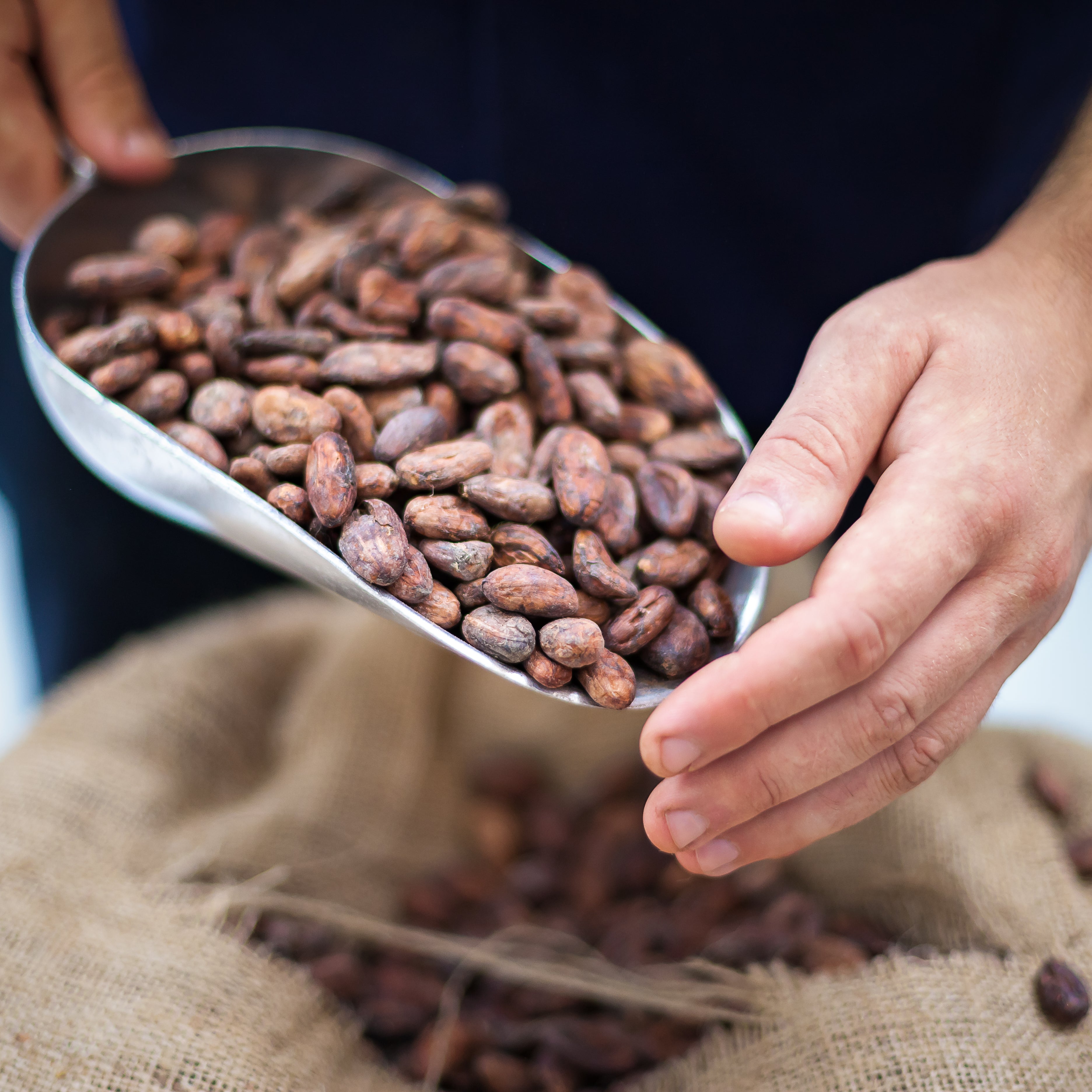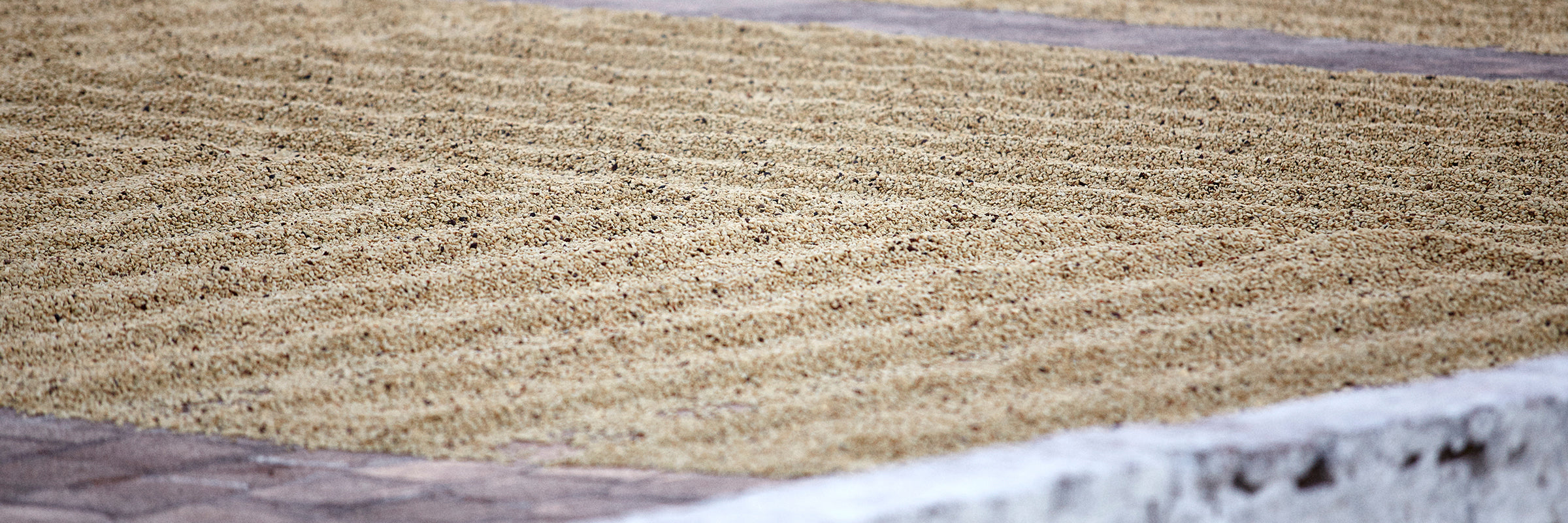
Behind the Scenes with: Land Chocolate
Meet Phil
Phil Landers had been enjoying a successful radio career with the BBC when a trip to Central America brought his lifelong love of chocolate back into focus. While a dramatic career change raised a few eyebrows, once Phil found himself making chocolate in his kitchen, he knew there was no turning back.
We caught up with the chocolate maker and self-confessed ‘sugar-hound’ to talk about sourcing and crafting speciality chocolate, and why he’s never made a chocolate Easter egg.

Reconnecting with Chocolate
Speaking with Phil, it’s impossible not to get caught up his enthusiasm over chocolate, though he’s quick to admit that he’s always ready to temper expectations when people – not just children – come to visit him at his workshop in London. “There are a few who are perhaps a little disappointed to discover I’m under an archway in Bethnal Green,” he said. “There’s no chocolate waterfall in sight, but there is a chocolate tap, which always pleases those who have seen any of the Charlie and the Chocolate Factory films!”
Phil’s enthusiasm for chocolate stems from childhood, not unironically, while his parents ran a health food shop. “As a boy, I was too young to properly appreciate the difference in chocolate—I simply remember the joy of going into the corner store to buy a chocolate bar: Snickers is still my guilty pleasure.” While introduced to the idea of a more sustainable choice though his parents store – which was one of the first places to stock Green & Black’s chocolate – it wasn’t until he went travelling that his palate and mind was introduced to a whole different route for chocolate.
Phil headed off with no real plan, choosing Central America on a whim. “Looking back, I was in a bit of a rut, and looking for some happiness. I met a couple of Australian girls while staying in a hostel in Guatemala, and they were great at signing up for absolutely anything: they convinced me to join them on a ‘Make your Own Chocolate Day’—how could I refuse?” he said. While Phil described the day as being “very touristy”, the experience had a lasting impact. “It was so eye-opening and interesting, visiting a cocoa farm and learning about the natural product. I’m pretty sure I just sprinkled some nuts on top of the chocolate, but I realised I hadn’t felt that excited since first getting into radio.” Taking away some cocoa beans and the chocolate he made that day (even if they were taken off him as he crossed the border), Phil returned to London with thoughts of chocolate firmly planted in his mind. Soon after he met up with an old friend who also worked at the BBC. “It was my birthday, and she’d bought me some chocolate from Paul A. Young. She was after some travel advice, and I was fresh back from my travels, meant to be returning to the BBC—and then she told me she’d seen a position for a sales assistant in the shop and I wondered if it was a sign,” Phil said.
Home Experimenting
While working for Paul A. Young, a chocolatier that Phil has huge respect for, he worked on building up confidence, exploring and experimenting with chocolate making from his kitchen. “I was very nervous in the beginning: I’d be making chocolate using my kitchen oven, an Indian spice mixer, a hairdryer, and a bowl—it was very DIY! And then I’d be sharing these creations with Paul, who has this incredible palate. There was one particular batch of Madagascan chocolate where I remember thinking, ‘no one’s just being nice here, pretending to like it’—they were really enjoying it. Those confidence boosts spurred me on.”
Keen to learn more, Phil went on to work for Mast Brothers as a chocolate maker in Shoreditch before returning to Central America. “There’s always something to learn, with so much room for experimentation. I’m no scientist at all—but the chocolate industry is full of engineers and scientists. I’ve remained fascinated by that very first stage of chocolate: sourcing and shaping it into something more accessible to people’s understanding.
“I’ll never be an expert,” he added. “You just try and be the best that you can be.” As far as Phil’s concerned, when it comes to experts, they’re found at the source. “I was so excited to be back on the farms; I was hanging out with the cocoa farmers, learning about the harvesting, fermenting, and drying, seeing it all firsthand,” Phil explained. “It’s crucial to be there, listening and learning—farmers are the experts.” It was on that trip that someone said to Phil, ‘you just need to start buying now’. And so he did.

New Landscape
Those farm trips clearly shaped Phil’s vision for the type of chocolate he wanted to source; how he wanted to work and support those farmers. “When I started, I thought about what I believe is the right way to do things—considering what chocolate can be; what it needs to be; looking for the best, but also fair—even beyond Fairtrade, which still isn’t good enough. There’s more to chocolate than people realise, but I don’t want to force the message down people’s throats. I want to show there’s a different way, through my chocolate. “
People are always excited when they learn I’m a chocolate maker—they want to talk to me at dinner parties and I probably ruin the mood!” he said. “Chocolate makes people smile—they don’t want to hear bad things about it!”
Despite treading lightly in conversations, Phil fervently believes that there is still a way for those conversations to take place, led through actions before words. “Chocolate is arguably one of the most popular food items in the world, with demand still going up, adding pressure to farmers while facing issues of climate change and deforestation, and yet the industry is still shrouded in mystery, and the public aren’t really told much about chocolate, where it comes from, how it’s harvested, how it’s made,” he explained. “Chocolate production was built on a colonial model, and it’s very broken. At those dinner parties, I want to talk about chocolate in the same way we talk about wine and coffee—showing it the respect it deserves. Some people question that £6 for the price of a bar of chocolate, but normally, by the end of the conversation, they can see that is makes sense.”
Making Chocolate an Everyday Pleasure
Back in London, when the cocoa arrives from those sourcing trips, it’s up to Phil and his team to turn those beans to bars, “unlocking the flavour” first through roasting, much as coffee roasters do when receiving green coffee beans. “Developing roast profiles can be a lot of trial and error; the whole process from start to finish is very hands on; from bean to bar takes about four days on average,” Phil said. After roasting, comes the process of cracking and winnowing (removing the outer shell from the cocoa bean to release the cocoa nib). The cocoa nibs – of which Phil tells us a fair few are needed for one batch of chocolate (about 40-50kg) – are then ground using a grinding stone to release the cocoa butter, which is a natural fat. Sugar, and any other ingredients required in the recipe are added to the grinder for between 48 and 72 hours until smooth, removing volatile acids and bringing out more nuanced notes. Conching follows next, adding heat and oxygen for those further notes and mouthfeel before moving onto the tempering machine for shine and snap, giving the chocolate structure. Finally, the chocolate is moulded into bars and hand wrapped. “These days I’m much more comfortable being a chocolate maker; being a chocolatier still blows my mind,” Phil admits, “but I am beginning to explore more.”

The Future of Land Chocolate
When it comes to exploration, Phil’s not looking to necessarily fall in line with the usual expectations of chocolate around holidays such as Easter. “I’ve never done a specific product,” he admits. “I’m not entirely against it but I see chocolate differently; it can be an everyday pleasure, rather than something just for certain occasions. I don’t want to lose the fun in chocolate—and no one’s complained that I’ve not made an Easter egg!”
Phil’s fascination with experimentation, bolstered by his confidence as a chocolate maker and chocolatier means he’s viewing seasonal occasions in terms of flavour. “I’ve been thinking of spring flavours, those that are savoury and unusual, spring notes like rosemary and orange,” he said.
Phil’s enthusiasm for chocolate shows no signs of slowing down, and while he’s not sure his dad is still entirely convinced by his career change to chocolate, he’s looking to the future more than ever, with a four-month-old son now in the picture.
“My girlfriend is more sensible than me, but I can’t wait for our little boy to have his first chocolate experience—I think his sweet tooth will be inevitable!
“There are challenges, of course, of running a small business, but no two days are ever the same: I can be test roasting one day or moulding and wrapping 400 bars the next; it’s a very fun place to be. I mainly try to avoid eating it all: there’s still that child within me, trying to eat all the chocolate.”
Pair your speciality coffee with a speciality chocolate bar: shop Phil’s exceptional Land chocolate range here.
You may also like
See all articles
Feb 28, 2025
Coffee Prices are Rising, but Why?
A short summary behind the upcoming price increase to coffee with regards to the why, and what we're doing to support our customers Read more

Feb 17, 2025
Winds of Change: Textile Artworks
Textiles and repair artist Amy Brock-Morgan makes remarkable tapestries from waste and remnant fabric. Read more

Feb 05, 2020
What's Coffee Processing?
Put simply, coffee processing is the removal of the layers that surround the coffee bean. In this article we take a closer look at the three... Read more











